Archive and forget
Introduction
There is wide concern about the non-reliability of Archiving Media typically available on the market today; whether physical or virtual, the performance of products seldom lives up to their marketing announcements
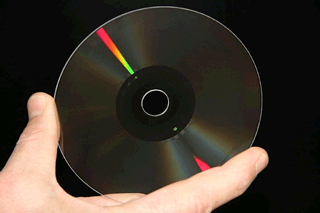 What are the choices proposed today?
What are the choices proposed today?
Optical Discs
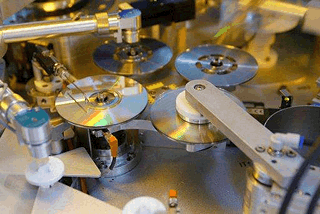 Very convenient for a quick Back-Up, & easy to use, they are (because of their Format) the only guarantee of a safe Play Back in the future (CD is already 30 years old).
Very convenient for a quick Back-Up, & easy to use, they are (because of their Format) the only guarantee of a safe Play Back in the future (CD is already 30 years old).
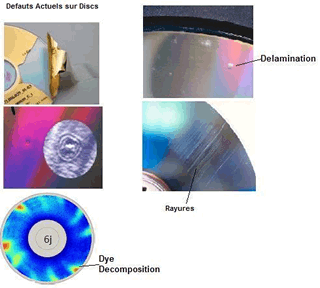 The components of the optical disc
The components of the optical disc
CD Format for Audio and DVD for Archive
We need to Sort our Data to Archiving
Reference Customers:Lockheed Martin, NASA, Thomson / Thalesgroup, Japan Aerospace Exploration Agency JAXA, Bibliothéque nationale de France, EDF, France Telecom, Musée Rodin, Avantis…
The Top Quality as only Requirement
Summary
References: BNF (Library of France), THOMSON, NASA...EDF, French Telecom,Avantis,...
Description of the SDG-Masterglass-Disc Technology
The Multiple Advantages of the SDG-Masterglass-Disc
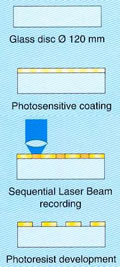 |
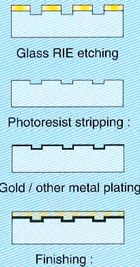 |
The Multiple Applications of the SDG-Masterglass-Disc
Why to choose the SDG-Masterglass Disc?
Mechanical and Chemical Resistance
| Comparison: | SDG-Masterglass Disc | CD/DVD |
|---|---|---|
| Optical | ||
transmission |
91% |
90% |
refraction |
1,5 |
1,58 |
birefringence |
2 nm |
30 nm |
| Mechanical | ||
weight |
33 g |
18 g |
hardness |
600 vickers |
70 rockwell |
maximum speed |
36 000 rpm |
4 000 rpm |
number of falls 1m |
350 000 |
>> |
dilatation |
8 10-6/*C |
70 10-6/*C |
test abrasion (Taber) |
OK |
NOK |
| Thermally | ||
low temperature |
-250 *C |
-150 *C |
high temperature |
350 *C |
80 *C |
transformation point |
550 *C |
140 *C |
Transparency, Flatness, Rigidity of this tempered glass are very important parameters for Life Time of the Datas
Time resistance
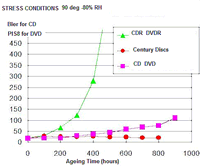 |
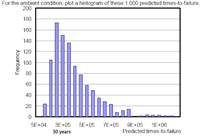 |
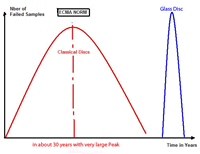 |
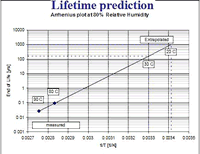 |
Multi-backups and copies useless
Recording Fidelity
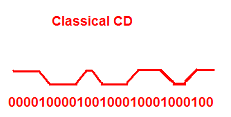 |
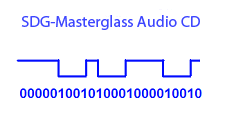 |
Lower Jitter (time clock pit jitter 13-15ns instead of 28-30ns for a Classical CD, 30-40ns for a CDR)
Form of etched pits (micro cups)
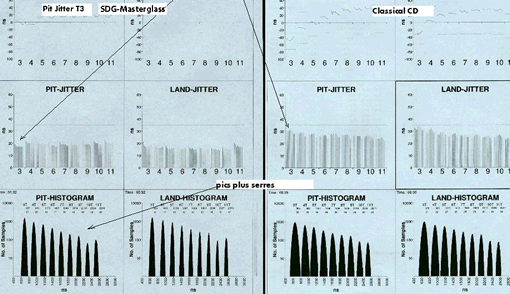 |
Recording Fidelity: Extract of the Glass Disc“SDG-Masterglass Disc and its Psycho-Acoustical Improvements” by Nicolas Bartholomée (famous french sound engineer)
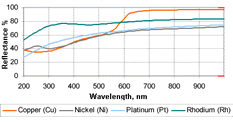 |
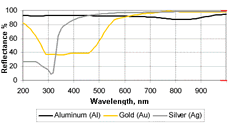 |
Recording Flexibility; Possible Customizing in mastering for every SDG-Masterglass-Disc:
Electrical Tests
Choice of Decorations and Reflectors
Customised Decoration:
Latest: long-term archiving on the glass discs etched with rectangular pits with no reflective layer
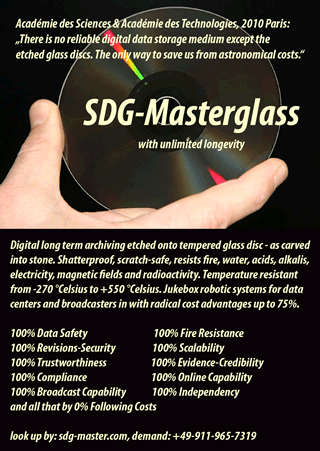 With the directly into the tempered glass discs etched pits, it is possible to produce grown in the pits for the optimal sampling rectangular shape. Thus the benefits of technology come with sharp edges and high slope even better coverage. The laser light reaches the photodiode steeper slopes in the output signal.
With the directly into the tempered glass discs etched pits, it is possible to produce grown in the pits for the optimal sampling rectangular shape. Thus the benefits of technology come with sharp edges and high slope even better coverage. The laser light reaches the photodiode steeper slopes in the output signal.
The pit structure achieved with this technology is so clean that the player can read them without a reflective layer. Only the intensity of the laser needs to be readjusted, what most players are able to do for themselves. This is especially important for long-term archiving, which can be dispensed by the reflective layer and the protective lacquer. So we can just use the glass discs. Of course, the gold-coated "traditional version is" still to choose from.
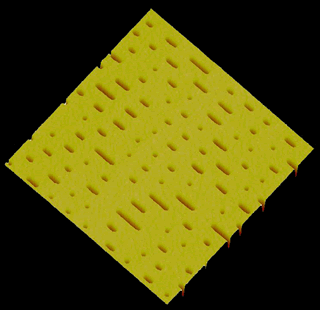 This product is the first and only media in the world, who holds up forever, "as carved into the stone."All magnetic data storage systems such as hard disks and magnetic tapes can be compared to our solution only for temporary use will be considered suitable. Most only as a backup but not as long-term archiving.
This product is the first and only media in the world, who holds up forever, "as carved into the stone."All magnetic data storage systems such as hard disks and magnetic tapes can be compared to our solution only for temporary use will be considered suitable. Most only as a backup but not as long-term archiving.
Therefore, globally, many libraries, computer centres, state and provincial archives, radio and television stations on our glass discs especially happy. The vast archives of film, video, tape or microfilm records and archives can be replaced with an unlimited durable medium, certainly saved.
Gone are the days when you had to just copy everything over again, where a fire, water or electricity damage could destroy valuable documents. Our glass discs must be done only once and accessibility, network or broadcast capability and forgery are secured forever.
A medium is the passive, requires no maintenance, no electricity, or cooling, heat, cold, acid resistant and completely without costs.
Our long-term archiving products and services we have listed here at Products > List of services Long-Term Archiving
| In this video you can see how the solar sail will open and where the glass-DVD is at the IKAROS probe |
JAXA IKAROS team with glass-DVD, Installation of glass-DVD on the spacecraft IKAROS, glass-DVD mounted on the spacecraft IKAROS |
Plasma etched Glass DVD with NASA Mars Expedition Phoenix with 250,000 names (including all Planetary Society Members) on Mars |
Etched glass DVD with Phoenix with 250,000 names (including all Planetary Society Members) on the Mars
Reference Customers: Lockheed Martin, Thomson / Thalesgroup, NASA, Bibliothéque nationale de France, EDF, France Telecom, Musée Rodin, Avantis…
The Japan Aerospace Exploration Agency, JAXA, sent on the 21th May 2010 the spacecraft IKAROS into space. This probe will use solar-photon sail.
On board he has is an etched glass DVD, which Planetary Society once again with a "Messages from representing the Earth." Just as in 2007 with the NASA Phoenix Mars expedition (see below).
In this video you can see how the solar sail will open and where the glass-DVD is at the IKAROS probe |
This time, however, the glass DVD out there in free space, that is, in minus 270 degrees Celsius and all cosmic and solar radiations exposed and vulnerable. The disc was produced by our technology director Pascal André. This serves as a new reference for our unlimited durable SDG-Master Glass archiving technologies.
JAXA IKAROS team with glass-DVD, Installation of glass-DVD on the spacecraft IKAROS, glass-DVD mounted on the spacecraft IKAROS |
Plasma etched Glass DVD with NASA Mars Expedition Phoenix with 250,000 names (including all Planetary Society Members) on Mars |
"White Papers" are usually structured like this:
1. 1. Detailed explanation of theories as interpreted according to personal taste, as the author of the original can not defend,
2. 2. Prior art, which suffers from the symptoms of the common theories
3. 3. Presentation of his own theory, with indication, why are all the other stupid,
4. 4. Evidence of his own theory, which because of their ignorance of others, devoted exclusively to combating certain symptoms,
5. 5. Bibliography in order to build a semblance of broad gauge and objectivity.
This method does not, we pursue! It carries many risks, come to wrong conclusions, interpret miss someone, possibly insulting, what do we really want to avoid.
Let us honour the representations are already known to specialists, we close the contacts short to eliminate subjectivity and fill any knowledge gaps. Please read the listed documents, you can clear up by sound scientific knowledge. Then, visiting on the Internet known institutes, companies and studios.
Take you questions directly to the scientists, designers, sound engineers or mastering engineer. You will be fascinated by the equipment arsenal of studio overwhelm almost limitless post-production facilities. Your information will be up to date, raised at the latest. Then, (below), we shall meet again!
SHANNON, C. E.: A Mathematical Theory of Communication, The Bell System Technical Journal, 1948
Ken Pohlmann, Applied Digital Audio, Introductory Binary Mathematics, McGraw Hill, 1995
Hicks, Christofer: What is Dither? MTSU
Mike J. Story: Timing Errors and Jitter, dCS Ltd, Great Chesterford, 1998
Bob Katz: Jitteressay. Digital Domain, 2002
Nika Aldrich, Dither Explained, Cadenza, 2002
DCA (Doug Carson & Associates), Eclipse Data Technologies, Datarius, Singulus Mastering, M2 Engineering
Audio Research Group, Stanley Lipschitz, John vanderkooy, Audio Engineering Society, Verband Deutscher Tonmeister, Audio Precision, dCS Ltd., Digidesign, Fraunhofer IIS, Fraunhofer IDMT
Emil Berliner Studios, Master Digital Corporation, Mastering Studio München, Galaxy Studios, Bauer Studios, Super Audio Mastering, AbbeyRoad Studios
Bert van der Wolf, dCS: DXD=Digital Extreme Definition, 352,8kS/s
Mark Levinson: Re-vitalizing Audio Industry: Music and Health, 2004
And then you ask about something that does not depend on the development of theories and many years: over glitches. From zero to one we had to switch from the outset. They will lead some very entertaining conversations! Perhaps also on the health of many professionals. And now about Long Term archiving:
Longévité de l’information numérique / Les données que nous voulons garder vont-elles s’effacer ? Academie de Sciences & Academie de Technologie, Erich Spitz, Franck Laloë, Jean-Charles Hourcade, Paris, 2010, Invitation pdf, Conclusion et Recommandations pdf, Résumé pdf, Présentation des auteurs du rapport.pdf
Mikroverfilmung im Kulturgüterschutz
Long-Term Preservation Services, A description of LTP services in a Digital Library environment.
A successful Kick-Off for the DCA Project: Digitising Contemporary Art for Europeana
GIS-DON archivage numerique fonctionnement enregistrement optique
Ministererklärung zum eGovernment, einstimmig angenommen in Malmö, Schweden, am 18. November 2009
William Kilbride: Risk Management in digital preservation. Digital Preservation Coalition, DPC, York, UK.